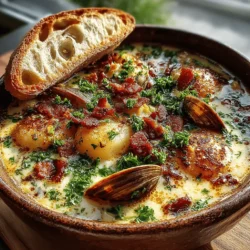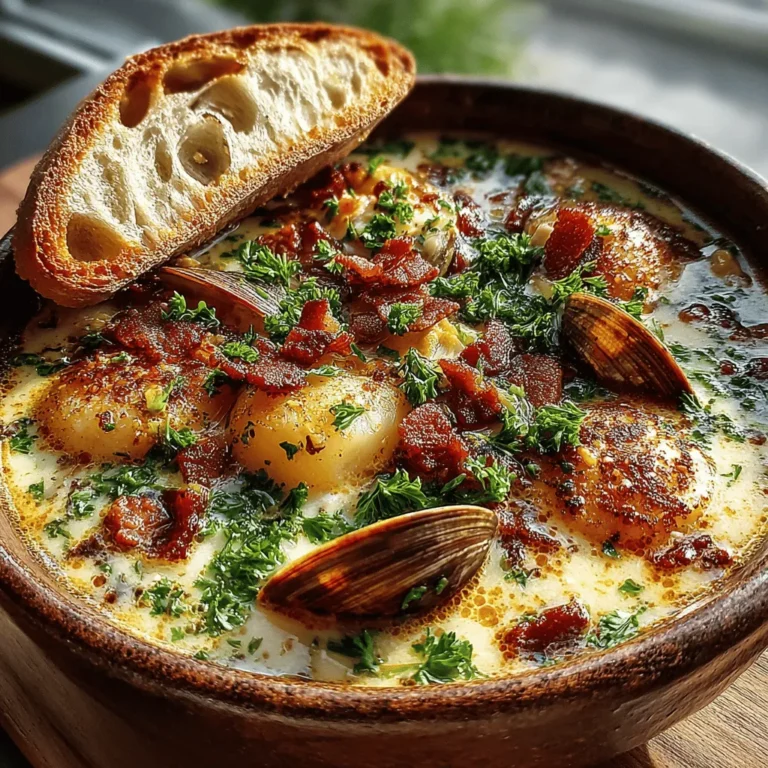Introduction to Creamy Classic New England Clam Chowder
New England clam chowder is more than just a soup; it’s a beloved emblem of American culinary heritage, particularly in the Northeastern United States. This creamy dish, rich in flavor and texture, has roots that trace back to the early settlers of New England, who adapted recipes from their European ancestors. Over time, clam chowder has evolved into a staple, often featured on menus ranging from quaint seaside diners to upscale restaurants.
At its core, creamy New England clam chowder offers a comforting blend of flavors that evoke images of cozy coastal evenings. The dish is characterized by its velvety texture, thanks in part to the inclusion of heavy cream and a medley of fresh ingredients. The combination of tender clams, crispy bacon, and hearty vegetables creates a delightful symphony of taste that has earned it a permanent place in the hearts (and stomachs) of seafood enthusiasts. Whether enjoyed on a chilly winter day or as a refreshing summer meal, clam chowder remains a dish that brings warmth and satisfaction.
As we journey into the kitchen to prepare this classic recipe, you’ll discover not only the essential ingredients but also the cooking techniques that elevate this chowder to its iconic status. Each component plays a vital role, contributing to the overall depth of flavor that makes this dish a perennial favorite.
The Essential Ingredients for New England Clam Chowder
To create a truly memorable New England clam chowder, it’s crucial to understand the key ingredients that contribute to its signature taste and texture. Each element harmonizes to create a rich and satisfying dish that seafood lovers cherish.
The Base Ingredients
Bacon
The first step in crafting the perfect clam chowder often begins with bacon. This ingredient is not only a source of flavor but also an essential component of the chowder’s foundation. As the bacon cooks, it releases its fat, providing a savory richness that enhances the overall taste of the chowder. The crispy bits of bacon that remain add texture and a delightful crunch, making each spoonful a satisfying experience. For the best results, choose thick-cut bacon, which will render down beautifully and infuse the chowder with its smoky essence.
Onion and Celery
Following the bacon, onion and celery are introduced into the pot. These aromatic vegetables are crucial for building the flavor base of the chowder. As they sauté in the rendered bacon fat, they soften and release their natural sweetness, creating a fragrant foundation that forms the backbone of the dish. The combination of onion’s sharpness and celery’s subtle earthiness provides a balance that complements the briny flavors of the clams.
The Heart of the Chowder
Clams
Clams are the star of the show in this chowder, and they come in two main varieties: fresh and canned. Fresh clams can be a delightful addition if you have access to them, as they offer a sweet, briny flavor that enhances the chowder significantly. If using fresh clams, choose varieties such as littlenecks or cherrystones and ensure they are cleaned thoroughly before cooking. Alternatively, canned clams are a convenient and accessible option that can still yield a delicious chowder. When using canned clams, opt for a high-quality brand and be sure to include the clam juice for added flavor.
Potatoes
The addition of potatoes not only thickens the chowder but also contributes to its heartiness. For the best texture, use starchy potatoes such as Russets or Yukon Golds. These varieties break down slightly during cooking, creating a creamy consistency that blends beautifully with the other ingredients. Cut the potatoes into uniform pieces to ensure even cooking, and allow them to simmer until tender, adding to the overall richness of the dish.
The Creamy Element
To achieve that signature creaminess that defines New England clam chowder, heavy cream and whole milk are essential. The richness of heavy cream provides a luxurious mouthfeel, while whole milk adds depth without overshadowing the other flavors. Incorporating both elements in the right proportions is key to creating a chowder that is indulgent yet balanced. As the chowder simmers, the combination of dairy melds with the other ingredients, resulting in a smooth and lavish texture that will have your taste buds singing.
Seasoning and Garnishing
The final touch to elevate your chowder lies in the seasoning. Fresh thyme and a bay leaf add aromatic depth, while salt and pepper enhance the natural flavors of the clams and vegetables. These simple seasonings are crucial, as they bring out the best in each ingredient without overpowering the dish. And for a burst of freshness, a sprinkle of chopped parsley serves not only as a garnish but also as a vibrant contrast to the creamy base, enhancing the chowder’s visual appeal.
Step-by-Step Instructions for Making Clam Chowder
Now that you have an understanding of the essential ingredients, it’s time to dive into the cooking process. Follow these detailed, step-by-step instructions to create your own creamy classic New England clam chowder.
1. Cook the Bacon
Begin by placing a large pot or Dutch oven over medium heat. Add the diced bacon and cook until it is crispy, stirring occasionally to ensure even cooking. Once done, use a slotted spoon to remove the bacon and set it aside on a paper towel-lined plate to drain. This step not only adds flavor but also provides a crunchy element to the finished chowder.
2. Sauté the Aromatics
In the same pot, retain about two tablespoons of the rendered bacon fat. If there is too much fat, you can drain some off, but be sure to leave enough to sauté the vegetables. Add the diced onion and celery to the pot, stirring frequently. Cook them until they are softened and translucent, about 5 minutes. This step is crucial as it builds the foundational flavor for your chowder.
3. Add the Potatoes
Once the onions and celery are softened, add the diced potatoes to the pot. Stir them in with the sautéed vegetables, allowing them to mingle for a couple of minutes. This will help coat the potatoes in the flavorful base of the chowder.
4. Incorporate the Clams
Next, add the clams to the pot, along with their juice if using canned clams. If you are using fresh clams, ensure they are cleaned and shucked before adding them. Pour in enough water or clam broth to cover the ingredients, and bring the mixture to a gentle boil. Reduce the heat, cover, and let it simmer until the potatoes are tender, approximately 15-20 minutes.
5. Finish with Cream
Once the potatoes are cooked through, stir in the heavy cream and whole milk. Adjust the heat to low, allowing the chowder to gently warm through without boiling. Taste and season with salt, pepper, thyme, and bay leaf to your liking.
Following these steps will guide you toward creating a bowl of creamy classic New England clam chowder that is sure to delight. With each spoonful, you’ll experience the comforting flavors and rich textures that have made this dish a cherished part of American culinary tradition.
{{image_2}}
Cooking the Bacon
To achieve perfectly crispy bacon, start by selecting high-quality, thick-cut bacon for the best texture and flavor. Place the bacon strips in a large, heavy-bottomed pot or Dutch oven over medium heat. Avoid overcrowding the pan, as this can cause the bacon to steam rather than crisp. Cook the bacon for about 8-10 minutes, turning occasionally, until it reaches a deep golden brown. The goal is to render the fat while ensuring the bacon crisps up nicely without burning.
Once the bacon is cooked to your liking, use a slotted spoon to transfer it to a paper towel-lined plate, allowing it to drain and cool. Crucially, do not discard the bacon fat in the pot; this rendered fat is essential for sautéing the vegetables and adds rich flavor to the chowder.
Sautéing the Vegetables
With the bacon fat still sizzling in the pot, it’s time to sauté the vegetables. Start by adding finely chopped onions and celery to the pot, stirring them into the fat. Sauté the vegetables over medium heat for about 5-7 minutes, or until they become translucent and fragrant. The goal is to soften the vegetables while allowing their natural sweetness to develop.
Next, add minced garlic and sauté for an additional minute, being careful not to let it burn. The aroma of sautéing vegetables should fill your kitchen, signaling that they are ready for the next step. At this point, the mixture should be aromatic and slightly caramelized at the edges, contributing to the overall depth of flavor in the chowder.
Incorporating the Potatoes and Broth
Once the vegetables are perfectly sautéed, it’s time to incorporate the potatoes and broth. Add diced potatoes, preferably Yukon Gold or Russet, to the pot. These varieties hold their shape well while cooking, providing a hearty texture to the chowder. Stir the potatoes into the vegetable mixture for about 2 minutes, allowing them to absorb the flavors.
Next, pour in the clam juice (or fish broth), which enhances the seafood flavor, and enough chicken broth (or vegetable broth, if preferred) to cover the potatoes. Bring the mixture to a gentle boil, then reduce the heat to a simmer. Cover the pot and let it cook for about 15-20 minutes or until the potatoes are tender, stirring occasionally to prevent sticking. This step is crucial for developing a flavorful base that forms the foundation of your clam chowder.
Adding Clams and Dairy
With the potatoes tender and the broth bubbling with flavor, it’s time to add the clams and dairy. If you’re using fresh clams, ensure they are well-scrubbed and rinsed. Add them to the pot, covering it again to allow the clams to steam and open, which should take about 5-7 minutes. If using canned clams, you can add them at this stage, along with their juice, to maintain the dish’s signature clam flavor.
Next, lower the heat to prevent boiling, and stir in the heavy cream. The cream gives the chowder its rich, velvety texture while balancing the briny flavor of the clams. Keep an eye on the chowder as it simmers gently for an additional 5 minutes, allowing the flavors to meld beautifully. Be cautious not to boil the chowder at this stage, as high heat can curdle the cream.
Simmering to Perfection
Simmering is an essential step in completing your clam chowder. Once you have added the cream and clams, continue to simmer the chowder for a few minutes until everything is heated through and well combined. Look for the clams to fully open; any that remain closed should be discarded, as they may not be safe to eat.
Taste the chowder at this stage; this is your opportunity to adjust seasoning if needed. A pinch of freshly ground black pepper or a dash of hot sauce can enhance the flavors significantly. If you prefer a touch of acidity, a few drops of lemon juice can brighten the chowder beautifully.
Final Seasoning and Serving Suggestions
Once the chowder achieves the desired flavor and consistency, it’s time for the final touches. Stir in the reserved crispy bacon bits for added texture and flavor. If you enjoy herbs, freshly chopped parsley or thyme can be sprinkled in just before serving to add a burst of freshness.
When ready to serve, ladle the chowder into bowls, garnishing each serving with additional bacon and a sprinkle of parsley. Serve with warm, crusty bread or oyster crackers on the side for a complete New England experience. The creamy chowder pairs wonderfully with a crisp green salad or a side of fried clams for a quintessential seaside feast.
The Cultural Significance of Clam Chowder in New England
Clam chowder holds a revered place in New England cuisine, celebrated for its comforting qualities and rich flavors. Originating from the region’s abundant seafood resources, clam chowder has evolved into various interpretations, with Manhattan and New England chowders being the most notable. While Manhattan chowder features a tomato base, New England clam chowder is characterized by its creamy texture, making it a staple in coastal restaurants and homes alike.
During the colder months, clam chowder emerges as a quintessential comfort food, often served at family gatherings and community events. Its heartiness not only warms the stomach but also evokes a sense of nostalgia tied to family traditions and coastal living. In many New England towns, clam chowder competitions highlight local culinary talent, showcasing how this dish unites people through shared culinary experiences.
Nutritional Information and Health Benefits
Creamy New England clam chowder is not just delicious; it also offers various nutritional benefits. Clams are an excellent source of lean protein, providing essential amino acids that support muscle health and recovery. They are also rich in vitamins and minerals, including vitamin B12, iron, and omega-3 fatty acids, which contribute to heart health and cognitive function.
The chowder’s use of potatoes adds fiber and vitamin C, while the vegetables contribute antioxidants and additional vitamins. While the heavy cream provides a rich flavor, it should be enjoyed in moderation. When prepared with fresh ingredients, clam chowder can be part of a balanced diet, offering a delightful way to enjoy seafood while nourishing your body.
Conclusion: Embracing the Comfort of Creamy Classic New England Clam Chowder
Creating and enjoying a bowl of creamy classic New England clam chowder is a culinary experience steeped in tradition and comfort. The combination of fresh clams, crispy bacon, and tender vegetables creates a dish that is both hearty and satisfying. This chowder encapsulates the essence of New England’s coastal heritage, bringing a taste of the sea right to your kitchen.
As you savor each spoonful, take a moment to appreciate the simplicity and warmth this recipe brings to your dining table. Whether enjoyed on a chilly evening or shared with loved ones during a gathering, clam chowder remains a cherished recipe that invites you to experience the rich culinary culture of New England. Embrace the comfort of this classic dish and let it inspire you to create warm memories and delicious meals for years to come.


